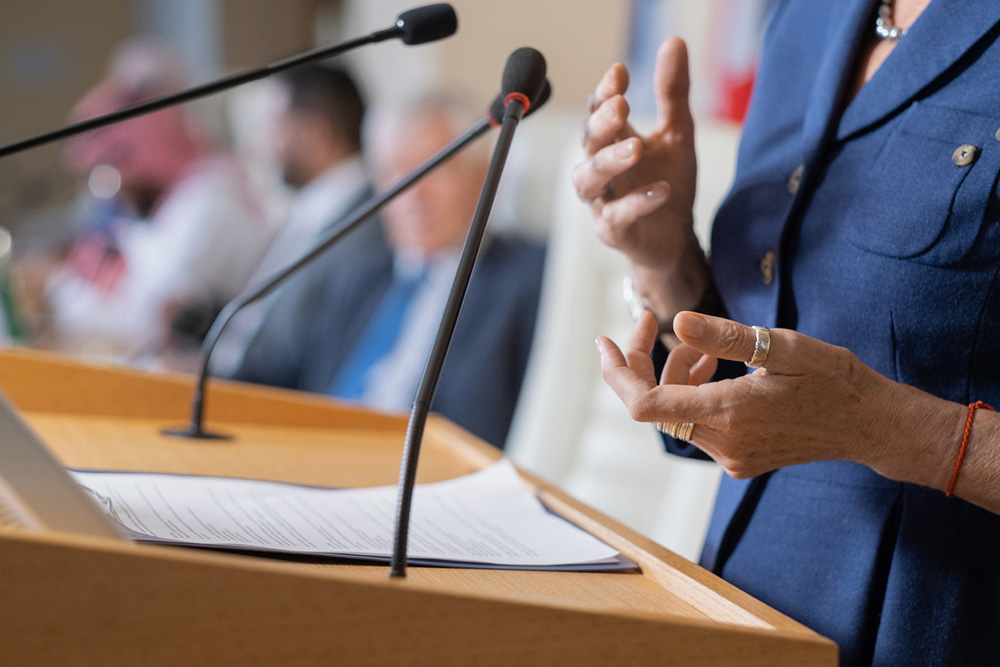Are Voters Biased Against Women Candidates?
Mary McGrath and Sara Saltzer find evidence that gender biases among primary voters contribute to the gender gap in office
Get all our news
The extent to which that bias is reduced suggests that voters are using candidate gender to make inferences about politically-relevant factors, like which candidate holds views closer to your own.”
Mary McGrath
IPR political scientist

In the 2020 election, a record number of Republican women won congressional elections around the country. Yet Republican women still represented a small minority of GOP politicians in the 117th Congress, holding less than 15% of their party’s seats, while women held 38% of the Democratic party’s seats. And those numbers hardly budged during the 2022 midterm elections—more than 70% of the women elected to the 118th Congress are Democrats.
These numbers reflect a growing trend. Since the 1990s, the partisan gender gap between female elected officials has increased as more Democratic women win seats in state legislatures and Congress, while the number of Republican women elected to office has remained flat.
In a new study published in Political Behavior, IPR political scientist Mary McGrath and Sara Saltzer (BA 2019), now a survey researcher at Morning Consult, explore why this partisan difference exists and what role voter bias may play in the gender gap. In addition to the fact that fewer Republican women run for elected office, they show the gap is due in part to partisan voters’ choices at the primary election stage. Registered partisans reproduce this gender-preference gap in experimental surveys, with Democrats showing a greater preference for female candidates than Republicans.
“We wanted to see what might be behind this gender-preference gap,” McGrath said. “Does it look more like prejudices unrelated to political reasoning—like a belief that women don't belong in office? Or do we see evidence that voters are using candidate gender to try to make inferences about where the candidate stands politically, which one would more closely reflect your own views?”
Voters in both parties typically assume that female candidates are more liberal than male candidates. These inferences may cause Republican voters to assume that female Republican candidates will be less likely to align with their policy beliefs than male Republican candidates. Democrats, on the other hand, are more likely to show a pro-woman bias, favoring female over male candidates.
McGrath and Saltzer conducted two survey experiments in 2019, asking nearly 2,500 registered voters from both political parties to choose between a male and female candidate running in a primary election for a U.S. House seat or a governorship. Both candidates were categorized as being moderate members of their party.
The researchers randomized respondents into three conditions. In one condition, candidates were indistinguishable except for their gender. In the other two conditions, participants either saw a pair of candidates whose policy stances reinforced gender-based stereotypes about candidates’ political beliefs, or a pair of candidates whose policy stances reversed those gender-based stereotypes.
The researchers also reinforced stereotypical character traits of women and men for some candidates and reversed them for others—with traits like “tough” and “ambitious” considered to be stereotypically male, and traits like “warm” and “trustworthy” as stereotypically female.
“We looked at character traits that have been considered stereotypically gender-linked in the literature,” McGrath explained.
The two researchers saw a reduction in bias when voters were presented with a candidate with counter-stereotypical policy stances.
“The extent to which that bias is reduced suggests that voters are using candidate gender to make inferences about politically relevant factors, like which candidate holds views closer to your own” McGrath said.
While registered Republicans and Democrats both showed some degree of gender bias, overall, the Republican respondents appeared closer to gender-neutral—with some indication that their gender preference was based more in stereotypically male character traits.
“These findings are preliminary, but they would suggest two things” McGrath said. “One, that the barriers for female candidates within the Republican party are hindering these relatively gender-neutral voters from arriving at greater gender-balance within their party. And two, that Republican women running for office may be better off emphasizing character traits that Republican voters care about, rather than feeling compelled toward ideological extremity in their policy positions.”
Mary McGrath is an assistant professor of political science and an IPR fellow.
Photo credit: iStock
Published: January 24, 2023.


